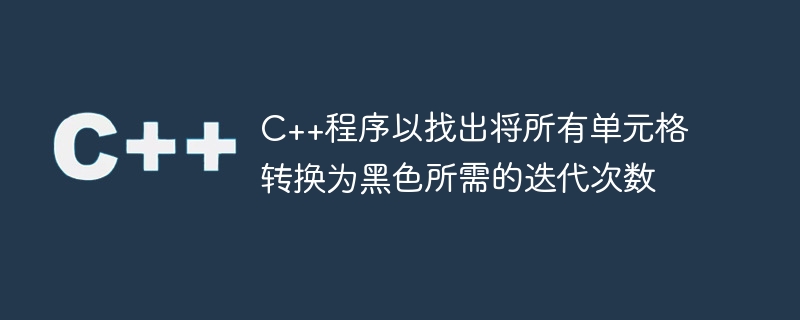C++程序以找出将所有单元格转换为黑色所需的迭代次数

假设,我们有一个包含两种类型单元格的网格;黑细胞和白细胞。黑色单元格表示为“#”,白色单元格表示为“.”。网格以字符串数组形式提供给我们。现在,我们必须执行以下操作。
我们将每个白色单元格转换为黑色单元格,并与黑色单元格共享一侧。我们执行此操作,直到网格的每个单元格都变成黑色。
我们计算将网格的所有单元格转换为黑色所需的迭代次数。一开始的网格必须包含一个黑色单元格。
因此,如果输入类似于 h = 4, w = 4, grid = {"#..." , ".#.." , "....", "...#"}
| # | . | . | . |
| . | # | . | . |
| . | . | . | . |
| . | . | . | # |
那么输出将为3。
需要3次迭代才能转换所有单元格为黑色。
步骤
为了解决这个问题,我们将按照以下步骤操作 -
Define an array dx of size: 4 containing := { 1, 0, - 1, 0 }
Define an array dy of size: 4 containing := { 0, 1, 0, - 1 }
Define one 2D array distance
Define one queue q that contain integer pairs
for initialize i := 0, when i < h, update (increase i by 1), do:
for initialize j := 0, when j < w, update (increase j by 1), do:
if grid[i, j] is same as '#', then:
distance[i, j] := 0
insert one pair(i, j) into q
while (not q is empty), do:
first element of auto now = q
delete element from q
for initialize dir := 0, when dir < 4, update (increase dir by 1), do:
cx := first value of now + dx[dir]
cy := second value of now + dy[dir]
if cx < 0 or cx >= h or cy < 0 or cy >= w, then:
if distance[cx, cy] is same as -1, then:
distance[cx, cy] := distance[first value of now, second value of now] + 1
insert one pair (cx, cy) into q
ans := 0
for initialize i := 0, when i < h, update (increase i by 1), do:
for initialize j := 0, when j < w, update (increase j by 1), do:
ans := maximum of ans and distance[i, j]
print(ans)示例
让我们看下面的实现以获得更好的理解 −
#include <bits/stdc++.h>
using namespace std;
void solve(int h, int w, vector <string> grid){
int dx[4] = { 1, 0, -1, 0 };
int dy[4] = { 0, 1, 0, -1 };
vector<vector<int>> distance(h, vector<int>(w, -1));
queue<pair<int, int>> q;
for (int i = 0; i < h; i++) {
for (int j = 0; j < w; j++) {
if (grid[i][j] == '#') {
distance[i][j] = 0;
q.push(pair<int, int>(i,j));
}
}
}
while (!q.empty()) {
auto now = q.front();
q.pop();
for (int dir = 0; dir < 4; dir++) {
int cx = now.first + dx[dir];
int cy = now.second + dy[dir];
if (cx < 0 || cx >= h || cy < 0 || cy >= w) continue;
if (distance[cx][cy] == -1) {
distance[cx][cy] = distance[now.first][now.second] + 1;
q.push(pair<int, int> (cx, cy));
}
}
}
int ans = 0; for (int i = 0; i < h; ++i) {
for (int j = 0; j < w; ++j) {
ans = max(ans, distance[i][j]);
}
}
cout << ans << endl;
}
int main() {
int h = 4, w = 4; vector<string>
grid = {"#...", ".#.." , "....", "...#"};
solve(h, w, grid);
return 0;
}输入
4, 4, {"#...", ".#.." , "....", "...#"}输出
3
以上是C++程序以找出将所有单元格转换为黑色所需的迭代次数的详细内容。更多信息请关注PHP中文网其他相关文章!

热AI工具

Undresser.AI Undress
人工智能驱动的应用程序,用于创建逼真的裸体照片

AI Clothes Remover
用于从照片中去除衣服的在线人工智能工具。

Undress AI Tool
免费脱衣服图片

Clothoff.io
AI脱衣机

AI Hentai Generator
免费生成ai无尽的。

热门文章

热工具

记事本++7.3.1
好用且免费的代码编辑器

SublimeText3汉化版
中文版,非常好用

禅工作室 13.0.1
功能强大的PHP集成开发环境

Dreamweaver CS6
视觉化网页开发工具

SublimeText3 Mac版
神级代码编辑软件(SublimeText3)

热门话题
 C语言数据结构:树和图的数据表示与操作
Apr 04, 2025 am 11:18 AM
C语言数据结构:树和图的数据表示与操作
Apr 04, 2025 am 11:18 AM
C语言数据结构:树和图的数据表示与操作树是一个层次结构的数据结构由节点组成,每个节点包含一个数据元素和指向其子节点的指针二叉树是一种特殊类型的树,其中每个节点最多有两个子节点数据表示structTreeNode{intdata;structTreeNode*left;structTreeNode*right;};操作创建树遍历树(先序、中序、后序)搜索树插入节点删除节点图是一个集合的数据结构,其中的元素是顶点,它们通过边连接在一起边可以是带权或无权的数据表示邻
 C语言文件操作难题的幕后真相
Apr 04, 2025 am 11:24 AM
C语言文件操作难题的幕后真相
Apr 04, 2025 am 11:24 AM
文件操作难题的真相:文件打开失败:权限不足、路径错误、文件被占用。数据写入失败:缓冲区已满、文件不可写、磁盘空间不足。其他常见问题:文件遍历缓慢、文本文件编码不正确、二进制文件读取错误。
 在C中如何有效地使用RVALUE参考?
Mar 18, 2025 pm 03:29 PM
在C中如何有效地使用RVALUE参考?
Mar 18, 2025 pm 03:29 PM
文章讨论了在C中有效使用RVALUE参考,以进行移动语义,完美的转发和资源管理,重点介绍最佳实践和性能改进。(159个字符)
 c上标3下标5怎么算 c上标3下标5算法教程
Apr 03, 2025 pm 10:33 PM
c上标3下标5怎么算 c上标3下标5算法教程
Apr 03, 2025 pm 10:33 PM
C35 的计算本质上是组合数学,代表从 5 个元素中选择 3 个的组合数,其计算公式为 C53 = 5! / (3! * 2!),可通过循环避免直接计算阶乘以提高效率和避免溢出。另外,理解组合的本质和掌握高效的计算方法对于解决概率统计、密码学、算法设计等领域的许多问题至关重要。
 如何使用C中的移动语义来提高性能?
Mar 18, 2025 pm 03:27 PM
如何使用C中的移动语义来提高性能?
Mar 18, 2025 pm 03:27 PM
本文讨论了使用C中的移动语义来通过避免不必要的复制来提高性能。它涵盖了使用std :: Move的实施移动构造函数和任务运算符,并确定了关键方案和陷阱以有效
 c语言函数的基本要求有哪些
Apr 03, 2025 pm 10:06 PM
c语言函数的基本要求有哪些
Apr 03, 2025 pm 10:06 PM
C语言函数是代码模块化和程序搭建的基础。它们由声明(函数头)和定义(函数体)组成。C语言默认使用值传递参数,但也可使用地址传递修改外部变量。函数可以有返回值或无返回值,返回值类型必须与声明一致。函数命名应清晰易懂,使用驼峰或下划线命名法。遵循单一职责原则,保持函数简洁性,以提高可维护性和可读性。
 c语言函数名定义
Apr 03, 2025 pm 10:03 PM
c语言函数名定义
Apr 03, 2025 pm 10:03 PM
C语言函数名定义包括:返回值类型、函数名、参数列表和函数体。函数名应清晰、简洁、统一风格,避免与关键字冲突。函数名具有作用域,可在声明后使用。函数指针允许将函数作为参数传递或赋值。常见错误包括命名冲突、参数类型不匹配和未声明的函数。性能优化重点在函数设计和实现上,而清晰、易读的代码至关重要。
 c语言函数的概念
Apr 03, 2025 pm 10:09 PM
c语言函数的概念
Apr 03, 2025 pm 10:09 PM
C语言函数是可重复利用的代码块,它接收输入,执行操作,返回结果,可将代码模块化提高可复用性,降低复杂度。函数内部机制包含参数传递、函数执行、返回值,整个过程涉及优化如函数内联。编写好的函数遵循单一职责原则、参数数量少、命名规范、错误处理。指针与函数结合能实现更强大的功能,如修改外部变量值。函数指针将函数作为参数传递或存储地址,用于实现动态调用函数。理解函数特性和技巧是编写高效、可维护、易理解的C语言程序的关键。






